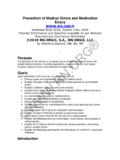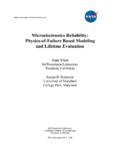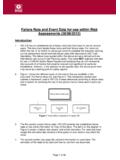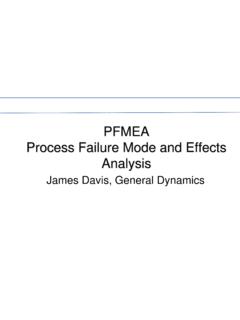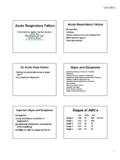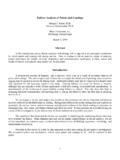Transcription of Acute Renal Failure - - RN.org®
1 Acute Renal Failure Reviewed February, 2018, Expires February, 2020 Provider Information and Specifics available on our Website Unauthorized Distribution Prohibited 2018 , , , LLC By Melissa K Slate, RN, BA, MA Objectives By the end of this learning experience, the clinician will be able to define Acute Renal Failure , discuss the three classifications of Acute Renal Failure and describe the four phases of Acute Renal Failure . Introduction Acute Renal Failure (ARF) or Acute Kidney Injury (AKI as it is now sometimes called in medical literature) has in the past had a very generic definition that generally consisted of: the abrupt decrease in Renal function that occurs over hours to days. However, this ambiguity has caused much debate and confusion. Recently the Acute Dialysis Quality Initiative (ADQI) adopted some guidelines to the treatment of ARF similar to the gold standard in chronic Renal Failure of the National Kidney Foundation DOQI guidelines.
2 The official definition called RIFLE adopted by ADQI is multifactoral and consists of the following components: Risk (R) - Increase in serum creatinine level X or decrease in GFR by 25%, or UO < mL/kg/h for 6 hours Injury (I) - Increase in serum creatinine level X or decrease in GFR by 50%, or UO < mL/kg/h for 12 hours Failure (F) - Increase in serum creatinine level X , decrease in GFR by 75%, or serum creatinine level > 4 mg/dL; UO < mL/kg/h for 24 hours, or anuria for 12 hours Loss (L) - Persistent ARF, complete loss of kidney function > 4 wk End-stage kidney disease (E) - Loss of kidney function > 3 months (Sinert). Acute Renal Failure is a common entity in the emergency room; and emergency room clinicians can play a pivotal role in the early recognition of this life-threatening event, reversing the cause of the destruction, and placing the patient on the path to return of Renal function.
3 It is important to recognize that there is a distinction between community acquired ARF and hospital acquired ARF. Hospital acquired ARF is most commonly seen in the ICU setting and is frequently a consequence of medical procedures or multi-system organ Failure . This type of ARF has the highest mortality rate and most often is the type that progresses to End Stage Renal Disease. Community acquired ARF is most often the result of volume depletion, which is usually and easily correctible situation and viable Renal function is restored in up to 90% of patients. Mortality rates are lower in patients not requiring dialysis and patients that do not become oliguric during their course of ARF. The clinical condition of Acute Renal Failure (ARF) is said to occur in anywhere from 1 to 25% of critically ill patients depending on the population being studied and the criteria used to define its presence.
4 Furthermore, mortality in these populations ranges from 28 to 90% (ADQI 2,1., 2003). The disease is usually manifested by elevated levels of blood urea nitrogen (BUN) and creatinine. Creatinine levels that are elevated to above 50% of baseline or increased indicate Acute Renal Failure . However, immediately after an insult to the kidney, BUN and creatinine levels may remain normal and the only symptom present may be diminished urine output. In addition, alterations in electrolyte balance, such as sodium and potassium and alterations in acid-base balance may occur. The most common causes are any condition that may interrupt the blood flow to the kidney such as Acute hypotension, dehydration, or cardiac arrest, and direct toxic effects to the kidneys as from medications or chemicals. AKF may occur in 3 clinical classifications, including the following: as an adaptive response to severe volume depletion and hypotension, with structurally intact nephrons (pre- Renal ), in response to toxic, ischemic, or inflammatory insults to the kidney, with structural and functional damage (intrinsic) and with obstruction to the passage of urine (post Renal ).
5 Pre- Renal conditions account for 50-80% of all the cases of Acute Renal Failure . Patients commonly present with symptoms related to hypovolemia, including thirst, decreased urine output, dizziness, and orthostatic hypotension. Hypotension and tachycardia are obvious clues to decreased Renal perfusion. Look for a history of excessive fluid loss via hemorrhage, GI losses, sweating, or Renal sources. Insensible fluid losses can result in severe hypovolemia in patients with restricted fluid access and should be suspected in the elderly and in comatose or sedated patients. Evaluation for hypovolemia should include evaluations for orthostatic hypotension, mucosal membrane moisture, and tissue turgor. Prerenal AKI can also result from decreased Renal perfusion in patients with heart Failure or shock (eg, sepsis, anaphylaxis). Patients with advanced cardiac Failure leading to depressed Renal perfusion may present with orthopnea and paroxysmal nocturnal dyspnea.
6 Angiotensin-converting enzyme (ACE) inhibitors and angiotensin receptor blockers (ARBs) are medications that are frequently used in the treatment or chronic Renal Failure ; however, these medications can cause ARF in volume-depleted states. Radiocontrast agents, nonsteroidal anti-inflammatory drugs (NSAIDs), amphotericin, calcineurin inhibitors, norepinephrine, vasopressor medications and hypercalcemia can all cause arteriolar vasoconstriction and ARF. With intrinsic Renal Failure , removal of tubular toxins and initiation of therapy for glomerular diseases decreases Renal afferent vasoconstriction (Sinert, 2006). Hepatorenal syndrome is considered a form of ARF due to the vasoconstriction of the blood vessels supplying the kidney. Pre- Renal disruptions in blood flow can lead to intrinsic damage if not corrected and treated early enough. The process of filtration within the kidney is dependent upon the pressure gradient from the glomerulus to the Bowman s space.
7 This pressure gradient is supplied by the degree of perfusion within the Renal vasculature. The insult begins with a period of decreased perfusion to the kidney usually with a mean arterial pressure (MAP) of less than 75mm Hg. This initiates several autoregulatory processes within the kidney to cause severe constriction of the arterioles supplying blood to the glomerulus. The adaptive mechanisms to hypoperfusion are autoregulation and release of rennin. In auto regulation, the blood flow to the glomerulus is regulated by constriction of the efferent arteriole and dilation of the afferent arteriole. This means that more blood is coming into the glomerulus than is leaving, and thus perfusion is increased. In addition, the kidneys release rennin, which activates the angiotensin-aldosterone system, which causes peripheral vasoconstriction and retention of sodium, thereby increasing blood pressure and Renal perfusion.
8 The increase in sodium also leads to the retention of water by releasing antidiuretic hormone. When these adaptive mechanisms fail to keep up with the degree of injury, ischemia results. Structural injury in the kidney is the hallmark of intrinsic AKI, and the most common form is Acute tubular necrosis (ATN), either ischemic or cytotoxic. Ischemia that lasts between 60-90 minutes causes irreversible damage within the kidney. This initial ischemic insult triggers production of oxygen free radicals and enzymes that continue to cause damage to the cells that often continues after the insult is removed. Blood flow can be reduced as much as 50%. The small blood vessels of the kidney are now more sensitive and less tolerant to changes in blood pressure and the effects of vasoconstrictive medications. These blood vessels loose the autoregulatory mechanism and the ability to vasodialate in response to decreased perfusion.
9 Any event which causes hypotension, including hemodialysis, can cause further damage to the kidneys. Careful monitoring and assessment of blood pressure is one of the primary preventions to avoid further Renal compromise. Tubular cellular damage results in disruption of tight junctions between cells, allowing back leak of glomerular filtrate and further depressing effective GFR. In addition, dying cells slough off into the tubules, forming obstructing casts, which further decrease GFR and lead to oliguria. Post Renal Failure occurs because of some obstruction in the urinary system below the level of the kidneys. Common causes of post Renal Failure include kidney stones, strictures, tumors, and enlarged prostate. If the obstruction only involves one side of the Renal collecting system between the Renal pelvis and the bladder, serum creatinine may remain normal as the function of the opposite kidney increases to meet the body s demands.
10 Patients who develop anuria typically have obstruction at the level of the bladder or downstream to it. Relief of urinary obstruction, results in decompression within the kidney and decreased vascular constriction restoring Renal blood flow and filtration. While these classifications are useful in differentiating the diagnosis, there is a lack of uniformity in the features of the different categories. This lack of consistency is a reflection of the diverse nature of the etiologies leading up to the injury. Rises in creatinine may be rapid or slow, but are always exponential, not linear. Therefore, each increment of elevation in creatinine is reflective of a multi-fold loss of nephron function. Creatinine mg/dL - Normal GFR Creatinine mg/dL - 50% reduction in GFR Creatinine mg/dL - 70 85% reduction in GFR Creatinine mg/dL - 90 95% reduction in GFR Differentiating between pre- Renal azotemia and ATN can be difficult.









